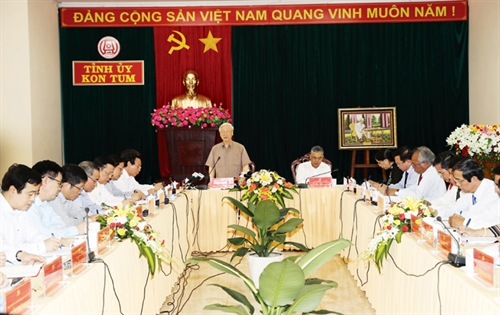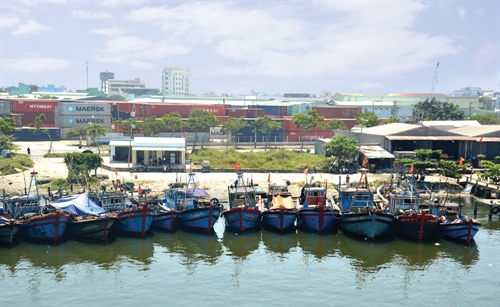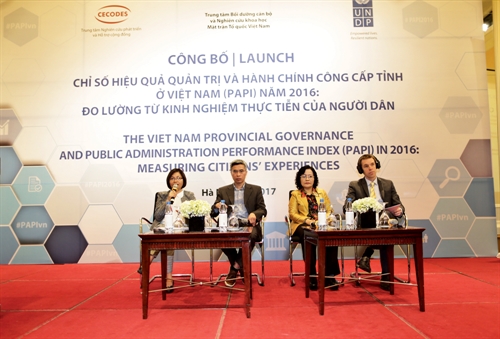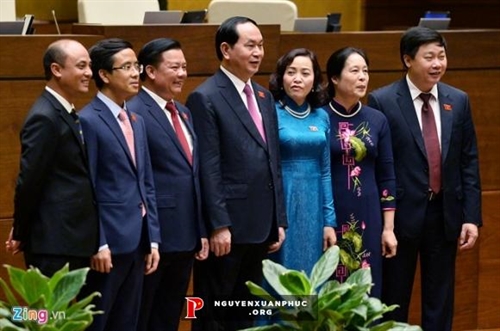Nguyen Hong Hai
Deputy General-Director
Department of Civil-Economic Laws, Ministry of Justice
As a law of the market economy, the 2015 Civil Code (the Code) contains substantially reformed provisions on property and ownership to make property truly become a commodity that can have its value maximized by different entities in different modes and on different scales.
Compared to the 2005 Civil Code, aside from ownership rights, the Code acknowledges two new rights of a person other than the owner of property, namely usufruct and the right of superficies.[1] Basically, these two rights are defined based on the principles of rights over property enshrined in many civil codes worldwide, under which the rights holders may directly control property owned by other entities.[2] This article deals with the right of superficies.
 |
| A corner of La CaSa complex of Van Phat Hung Corp. in Phu Thuan ward, District 7, Ho Chi Minh City__Photo: Internet |
Basics of the right of superficies[3]
The right of superficies is defined as the right of an entity over the ground, water surface, space above the ground or water surface, and the underground space of the land whose use rights belong to another entity.
The Code stipulates that the right of superficies will be established in accordance with a law, an agreement or a testament. The right of superficies takes effect from the time the holder of land use rights transfers the ground, water surface, space above the ground or water surface and the underground space of the land to the holder of the right of superficies, unless otherwise agreed upon or prescribed by a relevant law. The right of superficies takes effect for all individuals and legal persons, unless otherwise prescribed by a relevant law. So, like usufruct, the Code explicitly distinguishes the effect of the right of superficies between the holder of land use rights and the holder of the right of superficies and between the latter and a third party.
However, the Code has no specific provisions on holders of the right of superficies, so any individual or legal person may have this right. The Code states that the validity period of the right of superficies will be determined in accordance with a law, an agreement or a testament, but must not exceed the validity period of land use rights. If the validity period of the right of superficies is not specified, any party may terminate this right at any time but has to notify in writing to the other party at least six months in advance.
As for the contents of the right of superficies, the Code empowers its holder to exploit and use the ground, water surface, space above the ground or water surface and the underground space of the land whose use rights belong to another person for construction of works, growing of trees or cultivation, and have ownership rights over the created property not in contravention of this Code, the land, construction, planning, natural resources and minerals and other relevant laws. In case the right of superficies is transferred in part or in whole, the transferee may acquire this right according to the conditions and within the scope corresponding to the transferred part of the right.
The Code specifies bases for termination of the right of superficies, stating that upon termination of the right of superficies, its holder has to return the ground, water surface, space above the ground or water surface and the underground space of the land to the holder of land use rights as agreed upon or prescribed by law. The holder of the right of superficies is required to realize property under its ownership before this right terminates, unless otherwise agreed upon. If not, such property will belong to the holder of land use rights from the time the right of superficies terminates, unless such holder refuses to receive the property. If the holder of land use rights has to realize the property, the holder of the right of superficies must pay realization expenses.
Significance and legal characteristics of the right of superficies
First, the right of superficies bears an important significance as it helps ensure effective utilization of land resources and maximize the value of land-attached property and land use rights as well as guarantee the sustainable development of socio-economic relations. It serves as a legal basis for making clearer the relationship between land under ownership by the entire people and land use rights of organizations and individuals, and offering more options in exploiting land and land-attached property and exercising land use rights.
Together with other relevant provisions on making property registration public and separation of the effective time of transactions, time of transfer of the rights over property and time of effect for a third party, the Code’s provisions on the right of superficies and the legal relationship between the holder of this right and the holder of land use rights when they have common benefits from the same land parcel will help promote investment in land. Many owners will feel secure when allowing others to invest in, exploit and use their land use rights for economic purposes. In the same manner, non-owners will be more confident to invest in land areas under others’ ownership.
Let’s give an example. Mr. X has use rights over a land parcel of 1,000 m2. Instead of signing a contract for lease for exploitation with Mr. Y, the two men have agreed that Mr. X transfers the right of superficies to Mr. Y in accordance the Civil Code for a period of 50 years for the land use purpose and in the land use term prescribed by the Land Law. After receiving the right of superficies, Mr. Y builds a condominium and working offices for sale to other entities. According to the Code, other entities have ownership rights over the condominium apartments they have bought under the conditions and within the scope corresponding to the right of superficies Mr. X transferred to Mr. Y, and they may resell such apartments given the resale complies with the term and scope of the right of superficies Mr. X transferred to Mr. Y. In the long run, these provisions will help open the real estate market to foreign individuals and organizations, especially in owning immovable property established from the right of superficies.
In a broad sense, together with recognizing land use rights as property rights[4], the Code’s provisions on the right of superficies have helped “codify” the legal nature of the relationship between land under ownership by the entire people and lawful land use rights of individuals and organizations which are subject to registration under the Land Law. Accordingly, the holders of land use rights certificates will basically have the rights like the holders of the right of superficies over land under ownership by the entire people.
Besides, the Code’s provisions on the right of superficies also help the State adopt reasonable and sustainable policies on planning and investment, especially in agricultural production toward commodity production and land accumulation, without greatly affecting farmers who have to transfer land use rights to investors.
For example, a competent state agency permits company M to invest in an agricultural project after the model of commodity production on a land parcel of 500 ha (which belongs to lawful agricultural land use rights of 700 households). In this case, instead of the State’s recovery of this land for transfer to company M or instead of company M’s signing of contracts on lease of land use rights for exploitation with these households (which likely gives rise to disputes or contract breaches), these households may be allowed to transfer the ground, water surface, space above the ground or water surface, and the underground space of the land under their use rights to company M for use for implementing the project, for which these households will receive money paid for their right of superficies, or they may opt to contribute their land use rights as capital to the project. Upon the expiration of the investment period, company M will have to return the ground, water surface, space above the ground or water surface, and the underground space of the land to these households.
Second, compared to relevant obligatory relations, such as contracts for lease for exploitation, the holder of the right of superficies may establish, exercise and terminate this right and have this right protected on the principles applied to the rights over property, specifically:
(i) The right of superficies remains effective even in case the holder of land use rights transfers these rights to another, unless otherwise prescribed by the Code and relevant laws[5];
(ii) The holder of the right of superficies may perform all acts within its scope of its right as defined in the Code and other relevant laws without causing damage to or affecting the national interests, people’s interests or lawful rights and interests of owners of property or of other persons[6];
(iii) No one may be illegally restricted in or deprived of the right of superficies. The holder of land use rights may not reclaim these rights under the possession of the holder of the right of superficies over such use rights[7]. Meanwhile, the holder of the right of superficies is entitled to protect this right and prevent any infringements upon such right by lawful measures[8]. This entity may also reclaim the property from the person possessing, using or benefitting from the property without a legal basis[9];
(iv) The holder of the right of superficies will have to bear risks to the property within the scope of its right, unless otherwise agreed upon with the property owner or otherwise prescribed by the Code and relevant laws[10].
Compared to other rights over property (e.g., usufruct and easement), the holder of the right of superficies is vested with the “strongest” powers, such as acting as the owner of the ground, water surface, space above the ground or water surface, and the underground space of the land under the use rights of another entity. In addition to the right to use and benefit from, the holder of the right of superficies also has the right to disposition of the subject matters of the right of superficies within the term and scope of this right (easement and usufruct do not have all of these rights). Therefore, the right of superficies is predicted to exert the greatest legal and practical impacts in the spheres of land, housing, construction, real estate business, urban planning, agriculture, and mining.
Third, as analyzed above, the right of superficies as well as other rights over property are very powerful, so making this right public is of special importance for ensuring stability in property-related transactions and protecting the rights of bona fide third parties. Concerning this issue, in the course of drafting the Code, there were divergent opinions on the effect of the right of superficies. Some held that to ensure publicity, the Code should make clear provisions on the time when the right of superficies becomes effective for a third party in the direction that the right of superficies established under law is not subject to registration because such establishment has guaranteed the publicity of the right, while the right of superficies established under an agreement or a testament must be registered in order to publicize the establishment of this right according to the will of the entity and the time of effect of such right will arise from the time of registration. Others maintained that in the context that Vietnam already has a separate legal system regulating relevant civil relations, the Code’s provisions on the effect of the right of superficies are reasonable.
Concerning this matter, in the spirit of Clause 4, Article 95 of the 2013 Land Law on changes in land use rights to be registered, it may be construed that the right of superficies is also subject to registration?! The reason is that the right of superficies, once established over the land use rights of another person, will greatly affect the land use rights of this person who will be left with just the right to possession,
In my opinion, because of their novelty and close relationship with land, housing, construction and planning laws, the provisions on the right of superficies should be concretized in these laws. Registration of this right should be compulsory in order to guarantee the rights and benefits of land users and holders of the right of superficies while ensuring compliance with the Constitution and Land Law, which stipulate that land comes under ownership by the entire people and the unified management by the State and that social order and stability must be ensured in relevant relations. This also aims to distinguish more clearly relations under contracts for lease for exploitation and relations involved in the right of superficies.-
It is necessary to confirm that servitudes, usufruct and the right of superficies are not novel in Vietnam as they were included in the Southern Region’s Concise Civil Code 1883, Northern Region’s Civil Code 1931, Central Region’s Civil Code 1936, and former Saigon regime’s Civil Code 1972.









